São Paulo – “About 35 million Brazilians have no access to drinking water,” Ambev corporate relations executive Richard Lee told ANBA. March 2017 saw the Brazilian beverage company launch Ama, a bottled water brand whose revenues are 100% channeled into infrastructure works intended to bring fresh water to Brazil’s semi-arid areas – the parts of the country that are plagued by drought the most. By the end of this year, over 26,000 people are expected to have been catered to in 20 different communities across the states of Bahia, Ceará, Paraíba, Pernambuco and Piauí.
Ama is featured in the Brazilian pavilion at the Dubai electricity and water industry show Wetex 2018, in a stand organized by the Arab Brazilian Chamber of Commerce. According to Lee, its joining the trade show is a bid to inspire other businesses to roll out similar projects in their own countries, as well as introduce Ama water as a sustainable product. Wetex wraps up this Thursday (25).
“We hope to inspire companies to develop projects in a sustainable way. Should they wish to buy Ama water, they will be helping communities in Brazil. Good ideas are meant to be shared, and we are willing to speak and help out with prospective new projects, since the Gulf is as or more aware than Brazil when it comes to access to drinking water,” Lee declared.

Ama currently sees about BRL 2.7 million in profit. It makes community-specific assessments to get to the root of their problems. Solutions usually include drilling deep water wells, setting up solar panels to cut distribution costs and ensure sustainability, renovating inactive distribution systems, building cisterns and grey water reuse systems in schools, vegetable farming and training on environment, water resources and reuse systems.
Water scarcity in the Middle East
Data on water scarcity in the Middle East are available in World Bank reports. The 2018 survey Water Management in Fragile Systems: Building Resilience to Shocks and Protracted Crises in the Middle East and North Africa shows that the problem is widespread and mounting. Not long ago, several Middle East and North Africa countries had been struggling with managing their water resources sustainably and expanding their water and sanitation services efficiently.
According to the survey, the additional issue of weak institutional performance “has contributed to an intensification of water challenges and a deterioration of water services. Institutional failures to address water-related challenges can act as risk multipliers, compounding existing situations of fragility. But improving water management can contribute to building resilience in the face of protracted crises.” Click here for the full report.
Another World Bank report – Beyond Scarcity: Water Security in the Middle East and North Africa –, from 2017, notes that “Total water productivity in the Middle East and North Africa is only about half the world’s average.” Despite scarcity, water service fees in the region are among the lowest in the world, and GDP spending on water subsidies ranks among the highest, averaging at 2%. “Flood and drought risks are increasing and are likely to harm the poor disproportionately,” according to the World Bank. “Some 60% of surface water resources in the region are transboundary, and all countries share at least one aquifer,” which evinces a need for shared water management strategies. Climate-related economic losses are seen amounting to 6%-14% of GDP by 2050. Click here for the full report in English, French and Arabic.
Translated by Gabriel Pomerancblum




